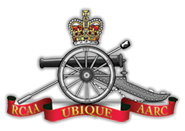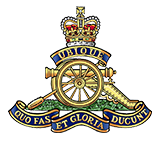Organization and Equipment 1968-92
The latter part of the 1960s and the early 1970s saw many changes that would affect The Royal Regiment of Canadian Artillery. As noted above, by an Act of Parliament on 1 February 1968, the Army, Navy and Air Force were integrated into the Canadian Armed Forces. During unification, it was decided that regiments would not be affected, but that the Corps of the Army would be disbanded and replaced by CF Branches. So, while all other Army Corps were disbanded, The Royal Regiment survived and also assumed the function of a CF Branch. Although all regimental uniform distinctions were initially abolished in the CF, Gunners were soon wearing their grenades and shoulder titles proudly once again.
As part of the formation of the Canadian Airborne Regiment on 8 April 1968, the 1st Airborne Battery RCA was created. It remained in Edmonton as an independent battery until 1977 when the Airborne Regiment was re-organized and moved to CFB Petawawa. At that time the 1st Airborne Battery was disbanded and E Battery, 2 RCHA was re-designated E Bty (Para).
On 6 May 1968 a Regular Force artillery unit returned to Québec City after an absence of nearly half a century. Le 5e Régiment d’Artillerie légère du Canada (5 RALC), the first Regular Force French-language Artillery regiment, was formed around a nucleus of Gunners from X Battery, 3 RCHA. As part of the personnel plan to create 5 RALC, it was decided that 4 RCHA would be reduced to nil strength. 5 RALC was initially equipped with towed 105mm howitzers, but took on its new colours, the 105mm L5 pack howitzers, in 1969. The L5 would also serve in the airborne and ACE Mobile Force Batteries in 2, 3 and 4 RCHA for duty on NATO’s Northern and Southern flanks.
3 RCHA moved to Shilo from Winnipeg in 1970 to fill the void left by the move of the School to Gagetown. On 15 July 1970, 4 RCHA in Petawawa was reduced to nil strength. The majority of its remaining equipment and personnel were transferred directly to 2 RCHA, which was moved from Gagetown to Petawawa.
In 1968, the M109 SP 155mm howitzer was introduced into service with 1 RCHA in Germany. A second buy of M109s in 1977 went to equip 3 RCHA. Eventually, both 3 RCHA and 5 RALC were equipped with M109s and were tasked to fly-over to Germany to reinforce Canada’s commitment to NATO as part of 1st Canadian Divisional Artillery (which was re-formed in the early 1980’s). 2 RCHA retained the ACE Mobile Force gun battery and the airborne battery roles for the remainder of the Cold War.
In 1975, in response to a new government commitment to protect airfields and army formations from air attack, two airfield air defence batteries were re-activated in Germany. These were 128 Airfield Air Defence Battery RCA at Baden-Soellingen, and 129 Airfield Air Defence Battery RCA at Lahr, both equipped with 40mm Boffin guns and Blowpipe missiles. The Boffin was a hydraulically driven naval version of the standard World War Two 40mm Bofors. In 1976, 1 RCHA and 2 RCHA each received a troop of Blowpipe air defence missiles. 3 RCHA and 5 RALC each added a Blowpipe missile equipped battery to their establishments, U and V Battery respectively. These are the only air defence batteries in RCHA history.
In the mid-1980’s, the army launched the Low Level Air Defence (LLAD) Project to re-equip the Army with modern LLAD weapon systems. The $1 Billion project was the most expensive single project to date for the Army, and resulted in the procurement of what was considered to be one of the most effective Short Range Air Defence (SHORAD) systems in the world. On 27 November 1987, 4th Air Defence Regiment RCA (incorporating 127, 128 and 129 Air Defence (AD) Batteries) was formed and headquartered in Lahr, Germany. The two air defence batteries protecting the airfields were each equipped with 4 Skyguard sections (each section comprising a Skyguard fire control radar and two twin 35mm Oerlikon GDF-005 air defence gun systems), and a troop of 4 of the Air Defence Anti-Tank System (ADATS) missile systems. 127 AD Battery, tasked with AD of 4 CMBG, was equipped with 12 ADATS. 119 AD Battery in Canada was also re-equipped with ADATS at this time. All other Regular AD batteries and troops were reduced to nil strength on the formation of 4 AD Regt.
In operations, 4 AD Regt was to be augmented with a troop of Javelin S15 missiles (which replaced Blowpipe in 1991) from each of three Militia units that had been re-equipped as air defence artillery – 1st AD Regiment in Pembroke, 18th AD Regiment in Lethbridge and 58th BAA (part of 6 RAC) in Levis, Quebec.
In 1992 as part of the reduction of forces and the return of units from Germany, 4th AD Regiment RCA was reduced to nil strength. It was raised again, but with a smaller establishment on 2l July 1996 as a Total Force unit, with a high ratio of reservists. The HQ and 128 AD Battery were located in Moncton, with 119 AD Battery and 210 AD Workshop located in Gagetown. A third battery worth of equipment was positioned at Cold Lake, Alberta with a small support staff.
Also a result of the downsizing of the Canadian Forces in 1992, 3 RCHA was reduced to nil strength. 1 RCHA moved from Germany, on the disbandment of 4 CMBG, to replace 3 RCHA in Shilo. 1993 saw the last parachute deployment of the L-5 howitzer with the deletion of a parachute capable battery from the Army. The guns of the three remaining Regular Force Field Regiments (1 RCHA, 2 RCHA and 5 RALC) were re-distributed, giving each unit a mix of two batteries of M109s and one battery of 105mm C1 Howitzers. In 1997, a new, longer range, light 105mm gun, the French LG1, replaced the C1 howitzers in the Regular Force units.
By 1992, the Reserve Force artillery was composed of 15 field artillery regiments, two air defence artillery regiments, two independent field artillery batteries and one air defence battery. The field regiments operated the C1 and C3 105mm towed howitzer. The air defence units operated the shoulder-launched Javelin S-15 SAM.
The end of the Cold War in 1992 created a period of uncertainty in Canadian defence, which had been focused for so many decades on the Soviet threat. The Royal Regiment struggled to define a secure role in an Army increasingly focused on peacekeeping as the most likely way ahead. Many senior leaders in the Army even began to think that maintaining an artillery capability was not affordable or even necessary.


